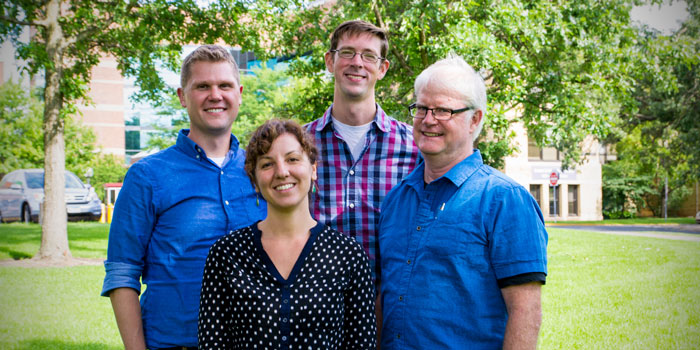
Clockwise from left: Cody Sheik, Will Harcombe, Jim Cotner, Mindy Morales
Second in a four-part series on the first round of research projects funded through the College of Biological Sciences' Grand Challenges in Biology Postdoctoral Program.
All water systems on the planet are connected. Living within these systems are teeming communities of microbes. Human activities like agriculture and urbanization can dramatically simplify terrestrial landscapes, often adding heaps of basic nutrients like carbon, nitrogen, and phosphorus to local watersheds. The microbial communities living there respond, in turn, by changing. These changes can ripple from nearby to distant ecosystems, causing dramatic problems like eutrophication of lakes and mass species die-offs in rivers and gulfs. As humans continue to alter the landscapes around us, protecting water quality everywhere has rapidly become one of the grand challenges facing our world.
“We must find ways to balance the needs of a growing human population with maintaining our water resources,” says Mindy Morales, one of four post-doctoral associates selected as part of the first cohort of the college's Grand Challenges in Biology Postdoctoral Program. Morales will spearhead an effort to understand how human-imposed changes on land affect waterways. In particular, she hopes to find out if terrestrial changes translate to a loss of biodiversity and function in downstream aquatic ecosystems.
A limnologist and biogeochemist, Morales has extensive experience studying algal blooms that can transform once-pleasant watering holes into sad, scummy ponds. By teaming up with Jim Cotner, Will Harcombe, and Cody Sheik, Morales will tie together decades of expertise in limnology, biogeochemistry, ecological stoichiometry, evolutionary ecology, and molecular biology.
Usually, fresh water goes sour when chemical and/or biological imbalances are introduced to the system. “The organisms and the products they make determine 99% of the biogeochemistry of a lake,” says Cotner, a limnologist with expertise in ecological stoichiometry. “I try to understand how organisms respond to the environment in terms of how much carbon, nitrogen, phosphorus and iron are inside of their cells, and where these compounds are located.”
Each microorganism deals with nutritive compounds on an individual scale. Yet the sum total activity of all the microorganisms in a lake determines how “productive” it is — i.e. how much life it supports and gas it produces. When a lake is highly productive, there’s often a problem.
Some lakes in agricultural areas have a large surface area but shallow depth. Partially due to continual fertilization, these highly productive lakes are rich in excess nutrients and overrun with microbes. “Small, shallow lakes are like chimneys of CO2 and methane,” says Cotner. “They release a lot of greenhouse gases into the atmosphere, contributing to global warming.”
Sheik, a geomicrobiologist and microbial ecologist based in Duluth, often takes samples from his own backyard, Lake Superior. “Superior is the third largest lake in the world by volume,” he says, noting it to be, on the contrary, a relatively non-productive, nutrient-limited body of water. “Most microbes in that environment are like a black box to us. We know that they're there, but we don’t know what they’re doing. My lab uses genomics to decipher the function of individual species in the environment.”
Harcombe, an evolutionary microbiologist, will help to piece together how the microbial species present in lakes interact with each other. “I study how intracellular metabolism gives rise to social interactions like cooperation and competition among species,” he says. “These interactions contribute to determining community composition, how it changes through time, and how carbon is respired.” Harcombe is excited to link small scale laboratory approaches to the much larger systems present out in the natural world.
As water flows among aquatic ecosystems, it carries with it both nutrients and microbes. Therefore, the problems present in highly productive lakes can have broad-reaching effects. Morales’ role will be to unite the research happening across many scales — from inquiries into local microscopic activity all the way to global phenomena.
“We're sampling lakes across a gradient of land use and water residence time, looking at how microbial communities change across those gradients,” says Morales, who will regularly be out on a canoe to gather field samples from various bodies of water.
Furthermore, with collaborators around the globe, Morales has access to data gathered continuously from approximately 200 lakes. Buoys stationed at key locations collect information about oxygen and nutrient levels every ten minutes. “We can compare our questions and findings here to things that are happening simultaneously on every continent,” she says.
Morales will also spend a lot of time in the lab, working with local collaborators on molecular analyses, microbial cultures, and metabolic models. “It's really exciting to approach these questions with tools that I don't currently have in my toolbox,” she says. “The Grand Challenges program will allow us to collaborate across disciplines and answer much larger scale questions than we could individually.”
Landscapes are routinely being engineered, and that has a huge effect on lakes. By learning more about how to quantify what a healthy lake is, and how and why it changes, this Grand Challenges team will contribute critical understanding that could inform decisions in landscape design, agriculture, and watershed planning — a vital first step towards globally mitigating human-imposed damage on water systems. - Colleen Smith